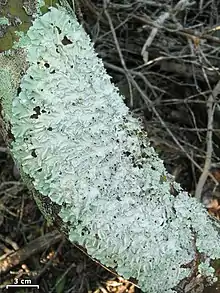| Parmotrema zollingeri | |
|---|---|
 | |
| Found in No Name Key, Florida | |
| Scientific classification | |
| Domain: | Eukaryota |
| Kingdom: | Fungi |
| Division: | Ascomycota |
| Class: | Lecanoromycetes |
| Order: | Lecanorales |
| Family: | Parmeliaceae |
| Genus: | Parmotrema |
| Species: | P. zollingeri |
| Binomial name | |
| Parmotrema zollingeri | |
| Synonyms[1][2] | |
Parmotrema zollingeri is a species of lichen in the family Parmeliaceae. It was originally described in 1860 as a species of Parmelia by German lichenologist Johann Adam Philipp Hepp, and named after Swiss botanist Heinrich Zollinger.[3] Mason Hale transferred it to the genus Parmotrema in 1974.[4]
The lichen has a pantropical distribution, and has been recorded in Australia,[5] East Africa, North, Central, and South America, and Southeast Asia.[2]
Description
Parmotrema zollingeri has a leathery thallus made of flat to concave lobes that are roughly laminate (divided into deep narrow irregular segments). Its spores measure 18–25 by 7–10 μm, while its conidia are more or less lageniform in shape (dilated below and tapering to a slender neck). The major secondary compounds in the medulla are fumarprotocetraric acid and succinoprotocetraric acid, while protocetraric acid is present in minor or trace amounts.[2]
See also
References
- ↑ "Synonymy: Parmotrema zollingeri (Hepp) Hale". Species Fungorum. Retrieved 3 May 2020.
- 1 2 3 Elix, John A. (1998). "Clarification of the synonymy and chemistry of Parmotrema zollingeri and related species" (PDF). Australasian Lichenologist. 42: 22–27.
- ↑ Zollinger, H. (1854). Systematisches Verzeichnis der im indischen Archipel in den Jahren 1842–1848 gesammelten sowie aus Japan empfangenen Pflanzen (in German). Zürich. p. 9.
{{cite book}}: CS1 maint: location missing publisher (link) - ↑ Hale, Mason E. (1974). "New combinations in the lichen genus Parmotrema Massalongo". Phytologia. 28 (4): 334–339.
- ↑ "Parmotrema zollingeri (Hepp) Hale". Checklist of the Lichens of Australia and its Island Territories. Australian Biological Resources Study. Australian Government: Department of the Environment and Water Resources. Retrieved May 3, 2020.